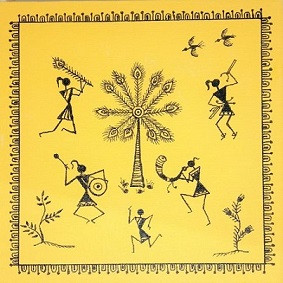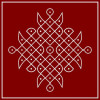Originating in the state of Maharashtra, Warli painting stands as the most excellent example of folk painting in India. This style of tribal painting was started in the early 10th century AD, mostly by the tribal group from the North Sahyadri Range in Maharashtra. The art is still practiced today in cities such as Dahanu, Jawhar, Talasari, Mokhada, Palghar, and Vikramgad in the Palghar district. Other examples of magnificent tribal artworks include Madhubani painting of Bihar, Tanjore painting of Tamil Nadu, Pattachitra painting of Orissa, Kalamkari painting of Andhra Pradesh, Gond painting of Madhya Pradesh, and so on.
History of Warli Painting
Even though this style of art dates centuries back, it was not until the 1970s that Warli Painting was recognized. The Warli tribe rejects contemporary culture and centers their art around the elements of nature. They were much dependent on farming for their source of food. Through their art, the tribe upheld their belief and respect for the concept of Mother Nature. Similar to the ways of the ancient people using cave walls as their backdrop for painting, the Warli artists used their clay huts as their canvases.
Techniques and Materials Used in the Painting
These exquisite art forms often illustrate a set of basic geometric shapes symbolic of different elements of nature. For instance, the celestial bodies are represented by circles, whereas the triangle shape represents mountains, pointed trees, and human bodies. Sceneries of hunting, fishing, festivals and dances are a few familiar illustrations. Tarpa dance is one of the central aspects depicted in these paintings.
A rudimentary technique is followed to elucidate the simple pictorial language of Warli painting. Usually, the paintings are found on the inner walls of village huts. For a contrasting background, a mixture of earth, red brick, and branches are used. These materials provide a red ochre colour, upon which white pigment is used for the paintings. The Warli tribe creates the paint by blending clay paste and water, with gum as a binder. For making the paintbrush, a bamboo stick or twig is used. One end of the stick is chewed to render the texture of a paintbrush.
Challenges Faced by the Warli Tribe
The Warli community feels the immediate need to preserve their original artworks and techniques of paintings. The community is struggling in constant fear of losing their original concepts of Warli art. The artists are keeping check that their upcoming generation acquires a thorough knowledge of the art form that still stands as their sole pride. The biggest challenge, in the present situation, is in terms of plagiarized Warli art. The artists still deserve notable recognition for their work. To preserve the Warli paintings as cultural intellectual property, the Adivasi Yuva Seva Sangh has registered them under the intellectual property rights act.
Artists of Contemporary Culture
Jivya Soma Mashe, the modern father of Warli painting, with his son Balu Mashe gave this ritual art a radical turn in the 1970s. Through their paintings, they expressed their artistic pursuits rather than ritual purposes. Alongside several national awards, Mashe was awarded Padmashree in 2011.
Current Scenario of Warli Painting
The simple mural-style painting has traversed much beyond the traditional tribal theme. In the present day scenario, this magnificent creation of the Warli tribe is considered to be a sophisticated art form. Platforms like ARTSofINDIA.in work to uphold such artforms and recognize the artists. They stand like a pillar and exhibit the work of such artists who are pouring their craftsmanship into this artform.
Being a traditional Indian art form, people all over the country have adopted it for a variety of decorative purposes. This escalation in demand for Warli paintings in urban centers has helped in evolving diverse styles and variations.
Picture Source: ARTSofINDIA.in



